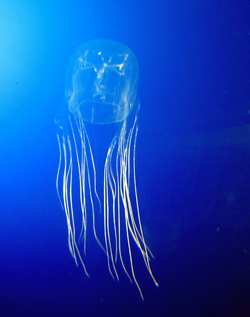Conversation 24: The essence of the crowd
Hello to our followers, this time we will address you in a different way and please let your imagination run wild…
The year was 2084, and the place was a spacious living room in an unnamed city. Alexey Gerbord sat in his chair looking from the height of his years at the huge water tank in front of him. The deadly box jellyfish, also known as the "Sea Wasp", appeared in front of him swimming slowly in the water of the huge aquarium that filled half of the living room of the house. This deadly jellyfish is called a cube jellyfish because of its body structure. With great effort, Garbord obtained it from the Indonesian sailor and tamed it because it was a complex jellyfish in its behavior and faster than other simple jellyfish, while its appearance, which deterred every human eye, spoke dearly to his heart. Its scientific name was Chironex fleckeri and its origin? You guessed it, from the Indonesian islands, it swam now peacefully in front of him, looking at him with her two dozen eyes, four of which were watching him with an almost human expression. Although he was wary of her and never reached out to shake her arms, he used to ask her questions that troubled him and disturbed his peace. Her answer was not in speech, but through thoughts that hurt his mind as if they were placed, inserted, or transmitted to his mind, something that psychiatrists used to call in the early 2000s as “though insertion”.
He has just finished reading the Machiavelli's “Prince” for the third time, each time pinning a page from the pages of the book to the transparent glass of the container and allowing the transparent jellyfish to observe and read as well. This jellyfish is thought to be mostly water and venom and "my God", Alexey thought "how can it read ? I will not understand, since it has no brain". And yet Alexey believed that her wisdom was greater than that of a human wisdom. And she even strangely often reminded him of the artificial intelligence such as CHAT GPT that had joined his life sixty years ago.

PICTURE 1
The deadly Cube jellyfish, also known as the "Sea Wasp"
This time he turned and asked her: "How is it that in our world, a limited number of people lead crowds led by these leaders?"… "How does this happen?" And you the reader may ask, "how did he asked this a creature which is unable to hear his voice?" The answer is that he showed her a page with the question on it. The jellyfish circled two or three times in the tank with its long arms clinging tightly to its sides, its white transparent body with purple silver streaks passed by him, and the answer appeared and flashed in his mind: "Those who are the led ones are influenced by shapers of public opinion who see their role in the necessity of shaping and correcting the opinion of the led crowd. These shapers represent a limited number of top leaders.” “It’s so reassuring, of course, for the people in the crowd” – added the jellyfish – “to quote these agitators and their words without them fully understanding the dilemmas that exist at the basis of the proposals and messages sent to them and even the possible solutions to these dilemmas other than the only solution offered to them according to the interests of the shapers."..…
"The propaganda of the shapers of public opinion" – continued the jellyfish – "is referring mainly not only to the intellect but also emphasizes emotional aspects, usually conveying targeted, simple, catchy and repeated messages to the crowd, which, as mentioned, arouses emotions to messages that the leaders and opinion shapers are interested in. And likewise, as it is usually presented in propaganda, there is a prominent hostile person, a group, an ideology, against whom the campaign of persuasion is directed."
She carried on: "Sigmund Freud in his essay on crowd psychology ("Group Psychology and the Analysis of the Ego") from 1921 in which Freud refers to the psychology of a society or crowd and especially to what he calls the "herd instinct", argues that there is a phenomenon of a crowd behaving in a regressive way. A crowd that drifts in the direction of those shaping its opinion without the individuals in the crowd really and deeply knowing why they behave and drift in this way, and don't even fully understand what it is all about. More often than not what motivates people is the sense of belonging to the group of the crowd of individuals, who now have a common goal designed for them that unites them. And being inspired by the opinion makers, they have a strong desire that others also join them, and they have a sense of urgency, and a feeling that a catastrophic scenario is about to come true, of an imminent disaster, and all of this is accompanied by very strong emotions."

PICTURE 2
Sigmund [Shlomo] Freud Austrian Jewish psychiatrist founder of psychoanalysis [1856-1939]
Freud in his writings mentions Gustave Le Bon, who in his book "Psychology of Crowds", writes:
"The most amazing thing about a crowd is that, by virtue of being a crowd, they become a collective soul, due to which they feel, think and act in a completely different way as a crowd than each of them would think and act if they were acting alone as an individual."

PICTURE 3
Gustave Le Bon, French psychologist and sociologist [1841-1931]
Le Bon claims that the crowd's tendency towards conservatism demonstrates a considerable weakness in its logical thinking. Its behavior is essentially emotional, and is based on myths, images and symbols, and tends to enjoy following leaders [and public opinion shapers] who will dictate its path. Le Bon, speaks of 'contagion' between the people of the crowd, a form of hypnosis-like phenomenon, in which the crowd is in a suggestible state. In a crowd, the feeling of responsibility is absent, an instinctive feeling of liberation appears accompanied by a feeling of power that can be called "the power of the crowd", a crowd that becomes impulsive and acts out of impulses. Such a crowd is susceptible to the influence of words and messages and their magical power."

PICTURE 4
An excited crowd.
"How does the jellyfish know that?" thought Gerbord Alexey, and at one point he remembered that the jellyfish sent a long arm to a pile of books that he had placed a week before near the water tank, a pile in which there were delicacies side by side, Freud's book, Le Bon's and Machiavelli's along with social psychology, history, and war books and these dropped from the arm of his friend the jellyfish into the water of the huge aquarium and soon they were wrapped in all dozens of its arms in front of its two dozens eyes and especially in front of its four well developed eyes and were finally digested and arrived into its transparent insides.
Here Alexey asked the jellyfish: "Tell me, what are the causes of mob mentality?" This time the jellyfish didn't go around in a circle in the aquarium and didn't even change its colors. "I will answer you," she replied, "what I learned from social psychology, since it lists six factors:
Deindividuation – when people are part of a group, they experience a loss of self-awareness.
Deidentification – when people are part of a group, they can lose their sense of personal identity.
Emotions – being part of a crowd induces heightened emotional states, be it excitement, anger, hostility, etc.
Acceptability – behaviors that are normally perceived as unacceptable become acceptable when others in the group are seen performing them
Anonymity – people feel anonymous within a large group, which reduces their sense of responsibility.
Diffusion of responsibility – being part of a group creates the perception that violent or unacceptable behavior is not a personal responsibility but a group responsibility.
Finally, the larger the group, audience or crowd, the greater the chance of de-individuation and diffusion of responsibility."
"I’ve got it," Alexey said to himself…"But sometimes", he thought, “it leads to disengagement, struggle and even killing"…"This reminds me of civil wars" thought Alexey. "This reminds me of divisions in families on the basis of identification with ethnic and other national groups while in the background there is a feeling of a strong threat to survival" he continued to think, and then Garbord Alexey turned to the jellyfish, which was now circling in the aquarium, closed its two dozen eyes and confirmed his last thoughts in his head.
"The main essence," the jellyfish's words suddenly struck in his mind, "is that in every society there is a small group that shapes public opinion and manipulates many people in order to achieve its goals. This happens whether in a small group, whether in an organization, or in a country. The leaders therefore use a group or a crowd that is led according to their goals by shapers of public opinion. And these shapers talk about the danger to survival and convince the crowd to put this as a top priority over other needs, even over basic needs such as eating, reproduction, etc. Hence, these shapers are therefore using the survival instinct in order to achieve their goals. The crowd is therefore a moldable body at the mercy its leaders."
Here Alexei turned again and again to the jellyfish until he begged, but for some reason the jellyfish was silent and no thought of her hurt his mind. So Alexei returned to her the next day, not before emptying a basket full of fish into the aquarium water that was soon wrapped around her long arms, swallowed by her intestine, where it was gradually digested, gradually decomposed and was seen through her transparent body.
"Tell me, my friend," he turned to jellyfish, "what are the mechanisms for activating the crowd?"
At first the jellyfish answered in his mind that "the crowd must know that there is an extremely dangerous and uncompromising enemy”.
"Secondly" she added, "a person must know that its life or freedom and even of those close to him are in danger."
A person must also be convinced that there is a heavy and threatening uncertainty in the current situation and that the enemy may prevail and that catastrophic consequences are eminent….The crowd must even believe that the absolute truth is on the side of the shaper of public opinion and perceive that blatant lies are being told by the opinion shapers and leaders of the opposing side."
Here the jellyfish circled twice in the tank waving her arms and added that "the crowd must believe that there is only one solution without any alternatives and that there should be no contact or negotiation with the enemy and finally she added that it is necessary for the crowd to believe that it must take an immediate action and there shouldn’t be any compromise."
“Indeed”, Alexey thought, "This is a universal mechanism. The thinking dictated to the crowd therefore becomes reductionist, dichotomous, one of black or white without intermediate shades, and the crowd must believe with all its heart that whoever is not with them is against them."
Here Alexei invited to his home his friends Dr. Igor Salganik and Prof. Joseph Levine, who are respected in their own eyes and even in his eyes, "And what would you say?" – he asked. But these two were amazed and shocked at the sight of the huge tank containing the jellyfish, with her eyes looking at them as if they were a prey, with the terrifying transparency of her organs.
Alexey, who sensed this, calmed them down, and handed them two transparent glasses with wine as clear as the aquarium water. Then Alexei spoke to them the previous words of the jellyfish as they appeared in his mind. And despite their reservations about the “monster”, these two psychiatrists agreed with her words and even added:
"We talked," these two said, "in a previous conversation that in a totalitarian country, the majority often change their way of thinking to the way of thinking of the dictator, for the sake of their mental and even physical survival, Thus the positions of the dictator or the totalitarian state take over, override their own positions. This is the essence of indoctrination. Here in each and every individual, in his 'directorate of internalized characters' that builds his 'social self', appears a new dictator-self which overrides the previous dictator-self of his inner directorate [see previous conversations]. In fact, the real figure of the external dictatorial leader becomes a new internalized 'dictator-self' in the individual's 'directorate of internalized figures' dictating positions characterized by black and white mode of thinking without intermediate shades.
Here, embarrassed and apologetic, Alexey asked his guests to wait in a nearby room, as he felt that it would be difficult for the sensitive jellyfish to speak to him and that she preferred privacy, he then turned again to this transparent and gelatinous jellyfish, though without a brain, having an incomprehensible wisdom in her body.
"Tell me my friend the jellyfish?" Alexey addressed her, "How can a person avoid being drawn into the tornado of the crowd and being cut off from its usual ways, and from its usual cognitive judgments ? Oh oh, as the jellyfish answered in Alexey's thought, shaking her arms in
the water, "I know this from my experiences with the masses of huge shoals of jellyfish that wash up on the shores of the seas, and I assume that a similar thing happens to humans as well." Jellyfish continued with her thought, "Please let humans know the mechanisms of manipulation. Draw
before your eyes the image of a satanic enemy, who tries to convince you to perceive and understand a given situation as a threatening danger for you, which could fatally harm your physical or symbolic survival, trying to convince you that there is only one solution to this that the leader is the only one who knows.
In such a situation, you humans, should try to avoid as much as possible exposure to the media or to people who carry out such a practice, especially try to avoid discussions with people or a group of people who are already affected by these manipulations. Be aware of their attempts to get you to
let them know which side you are on in the situation. Do not share your positions and points of view with them. Be careful, look for reputable people who are known to stand up to manipulation, who see multiple points of view and don't see things in black and white dichotomous thinking manner. Sometimes these people will even swim against the current of the crowd. Try to understand their way of thinking and dealing with such situations, and if possible – try to establish contact with them and cooperate with them…
Also, try to continue with your normal flow of life in the family, with friends, at work, in the pursuit of hobbies, and do not allow yourself to be excessively preoccupied with the subject that is at the center of the manipulation effort… Finally, try to inform yourself about the subject in question
through various and diverse sources that provide different points of view that will allow you to form your own opinions."
Here the jellyfish was lighthearted and splashed its many arms in the aquarium water until they drifted and swelled like a sigh as if to say that it is not easy not to drift with the crowd and form an independent opinion.
"And what do you think could be a solution?", Alexey asked, the jellyfish "for situations in which there are two sides, each led by manipulative public opinion shapers, who give each side the feeling that its survival is in tangible and immediate danger, and it is forced to act against the enemy that is the opposing side?"
The jellyfish spined around in the tank, the fish still being digested and sprouted from her transparent intestine, inserting six ways of solving the problem into Alexey's mind:
"1] As soon as the anxiety about the conflict is already more intense than the survival anxiety of each side, there might appeara mediator, actually a newer, independent public opinion shaper. He should be accepted by both parties addressing the survival fears of each party offering a compromise that meets and resolves the fears of both parties.
2] The appearance or rise of a powerful third dictatorial factor that dictates a solution sometimes even by force of arms or through powerful sanctions.
3] Severe damage to one of the opponent groups [and thus actually the second group wins] which weakens it and enables a solution.
4] Gradual stabilization of the conflict, becoming chronic while developing mechanisms of adaptation to the new established conditions.
5] The emergence of a strong existential threat from another factor that brings the hawks to unite in the war against it.
6] Existence of a hidden structured mechanism that exists in both groups all the time (only that they are not aware of it) which enables change within a longer time span.
7] The introduction of external influences or changes in values that will gradually change the conflict’s definition and provide a solution.
That's it gentlemen for the time being,
Best regards
The deadly cube jellyfish also known as the "sea wasp" and her friend Alexey Garbord.
and, as always, yours
Dr. Igor Salganik and Prof. Joseph Levine
 Prof. Joseph Levine, M.D. is an emeritus associate professor in the Division of Psychiatry, Faculty of Health Sciences, Ben Gurion University in Israel. Prof. Levine is a certified psychiatrist with clinical experience in controlled trials of adult psychiatric disorders and in psychotherapy. He was awarded a NRSAD independent investigator grant for the study of Creatine Monohydrate in psychiatric disorders -- mainly Schizophrenia. He resides and treats patients in Tel Aviv and all of central Israel.
Prof. Joseph Levine, M.D. is an emeritus associate professor in the Division of Psychiatry, Faculty of Health Sciences, Ben Gurion University in Israel. Prof. Levine is a certified psychiatrist with clinical experience in controlled trials of adult psychiatric disorders and in psychotherapy. He was awarded a NRSAD independent investigator grant for the study of Creatine Monohydrate in psychiatric disorders -- mainly Schizophrenia. He resides and treats patients in Tel Aviv and all of central Israel.
Leave a comment